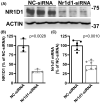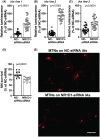NR1D1 downregulation in astrocytes induces a phenotype that is detrimental to cocultured motor neurons
- PMID: 35319791
- PMCID: PMC9223394
- DOI: 10.1096/fj.202101275R
NR1D1 downregulation in astrocytes induces a phenotype that is detrimental to cocultured motor neurons
Abstract
Nuclear receptor subfamily 1 group D member 1 (NR1D1, also known as Rev-erbα) is a nuclear transcription factor that is part of the molecular clock encoding circadian rhythms and may link daily rhythms with metabolism and inflammation. NR1D1, unlike most nuclear receptors, lacks a ligand-dependent activation function domain 2 and is a constitutive transcriptional repressor. Amyotrophic lateral sclerosis (ALS) is the most common adult-onset motor neuron disease, caused by the progressive degeneration of motor neurons in the spinal cord, brain stem, and motor cortex. Approximately 10%-20% of familial ALS is caused by a toxic gain-of-function induced by mutations of the Cu/Zn superoxide dismutase (SOD1). Dysregulated clock and clock-controlled gene expression occur in multiple tissues from mutant hSOD1-linked ALS mouse models. Here we explore NR1D1 dysregulation in the spinal cord of ALS mouse models and its consequences on astrocyte-motor neuron interaction. NR1D1 protein and mRNA expression are significantly downregulated in the spinal cord of symptomatic mice expressing mutant hSOD1, while no changes were observed in age-matched animals overexpressing wild-type hSOD1. In addition, NR1D1 downregulation in primary astrocyte cultures induces a pro-inflammatory phenotype and decreases the survival of cocultured motor neurons. NR1D1 orchestrates the cross talk between physiological pathways identified to be disrupted in ALS (e.g., metabolism, inflammation, redox homeostasis, and circadian rhythms) and we observed that downregulation of NR1D1 alters astrocyte-motor neuron interaction. Our results suggest that NR1D1 could be a potential therapeutic target to prevent astrocyte-mediated motor neuron toxicity in ALS.
Keywords: NR1D1; Rev-erbα; amyotrophic lateral sclerosis; astrocytes; inflammation; motor neurons.
© 2022 The Authors. The FASEB Journal published by Wiley Periodicals LLC on behalf of Federation of American Societies for Experimental Biology.
Figures







References
-
- Yin L, Wu N, Curtin JC, et al. Rev‐erbalpha, a heme sensor that coordinates metabolic and circadian pathways. Science. 2007;318:1786‐1789. - PubMed
-
- Renaud JP, Harris JM, Downes M, Burke LJ, Muscat GE. Structure‐function analysis of the Rev‐erbA and RVR ligand‐binding domains reveals a large hydrophobic surface that mediates corepressor binding and a ligand cavity occupied by side chains. Mol Endocrinol. 2000;14:700‐717. - PubMed
Publication types
MeSH terms
Substances
Grants and funding
LinkOut - more resources
Full Text Sources
Medical
Molecular Biology Databases
Research Materials
Miscellaneous

